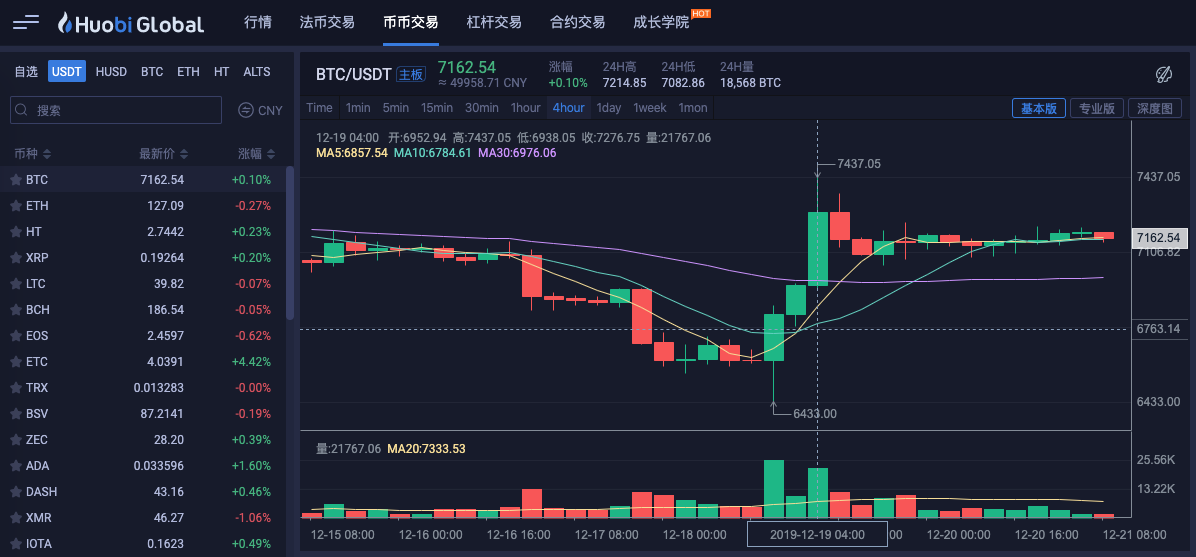Ensina passo a passo como escrever uma versão Python da função de síntese K-line
 4
4
 2834
2834

Ensina passo a passo como escrever uma versão Python da função de síntese K-line
Ao escrever e usar estratégias, alguns dados incomuns do ciclo da linha K são frequentemente usados. No entanto, as bolsas e fontes de dados não fornecem dados para esses períodos. Ele só pode ser sintetizado usando dados de ciclos existentes. O algoritmo de síntese já possui uma versão JavaScript (Link), na verdade, é muito simples portar um código JavaScript para a versão Python. A seguir, vamos escrever uma versão Python do algoritmo de síntese K-line.
Versão JavaScript
function GetNewCycleRecords (sourceRecords, targetCycle) { // K线合成函数
var ret = []
// 首先获取源K线数据的周期
if (!sourceRecords || sourceRecords.length < 2) {
return null
}
var sourceLen = sourceRecords.length
var sourceCycle = sourceRecords[sourceLen - 1].Time - sourceRecords[sourceLen - 2].Time
if (targetCycle % sourceCycle != 0) {
Log("targetCycle:", targetCycle)
Log("sourceCycle:", sourceCycle)
throw "targetCycle is not an integral multiple of sourceCycle."
}
if ((1000 * 60 * 60) % targetCycle != 0 && (1000 * 60 * 60 * 24) % targetCycle != 0) {
Log("targetCycle:", targetCycle)
Log("sourceCycle:", sourceCycle)
Log((1000 * 60 * 60) % targetCycle, (1000 * 60 * 60 * 24) % targetCycle)
throw "targetCycle cannot complete the cycle."
}
var multiple = targetCycle / sourceCycle
var isBegin = false
var count = 0
var high = 0
var low = 0
var open = 0
var close = 0
var time = 0
var vol = 0
for (var i = 0 ; i < sourceLen ; i++) {
// 获取 时区偏移数值
var d = new Date()
var n = d.getTimezoneOffset()
if (((1000 * 60 * 60 * 24) - sourceRecords[i].Time % (1000 * 60 * 60 * 24) + (n * 1000 * 60)) % targetCycle == 0) {
isBegin = true
}
if (isBegin) {
if (count == 0) {
high = sourceRecords[i].High
low = sourceRecords[i].Low
open = sourceRecords[i].Open
close = sourceRecords[i].Close
time = sourceRecords[i].Time
vol = sourceRecords[i].Volume
count++
} else if (count < multiple) {
high = Math.max(high, sourceRecords[i].High)
low = Math.min(low, sourceRecords[i].Low)
close = sourceRecords[i].Close
vol += sourceRecords[i].Volume
count++
}
if (count == multiple || i == sourceLen - 1) {
ret.push({
High : high,
Low : low,
Open : open,
Close : close,
Time : time,
Volume : vol,
})
count = 0
}
}
}
return ret
}
Se houver um algoritmo JavaScript, ele pode ser traduzido e transplantado para Python linha por linha. Ao encontrar funções internas ou métodos inerentes do JavaScript, basta procurar os métodos correspondentes em Python, então o transplante é relativamente fácil.
A lógica do algoritmo é exatamente a mesma, apenas a chamada da função JavaScriptvar n = d.getTimezoneOffset()Quando portado para Python, use a biblioteca de tempo do Pythonn = time.altzonesubstituir. Outras diferenças estão apenas na sintaxe da linguagem (como o uso de loops for, diferenças em valores booleanos, diferenças no uso de logical and, logical not, logical or, etc.).
O código Python transplantado:
import time
def GetNewCycleRecords(sourceRecords, targetCycle):
ret = []
# 首先获取源K线数据的周期
if not sourceRecords or len(sourceRecords) < 2 :
return None
sourceLen = len(sourceRecords)
sourceCycle = sourceRecords[-1]["Time"] - sourceRecords[-2]["Time"]
if targetCycle % sourceCycle != 0 :
Log("targetCycle:", targetCycle)
Log("sourceCycle:", sourceCycle)
raise "targetCycle is not an integral multiple of sourceCycle."
if (1000 * 60 * 60) % targetCycle != 0 and (1000 * 60 * 60 * 24) % targetCycle != 0 :
Log("targetCycle:", targetCycle)
Log("sourceCycle:", sourceCycle)
Log((1000 * 60 * 60) % targetCycle, (1000 * 60 * 60 * 24) % targetCycle)
raise "targetCycle cannot complete the cycle."
multiple = targetCycle / sourceCycle
isBegin = False
count = 0
barHigh = 0
barLow = 0
barOpen = 0
barClose = 0
barTime = 0
barVol = 0
for i in range(sourceLen) :
# 获取时区偏移数值
n = time.altzone
if ((1000 * 60 * 60 * 24) - (sourceRecords[i]["Time"] * 1000) % (1000 * 60 * 60 * 24) + (n * 1000)) % targetCycle == 0 :
isBegin = True
if isBegin :
if count == 0 :
barHigh = sourceRecords[i]["High"]
barLow = sourceRecords[i]["Low"]
barOpen = sourceRecords[i]["Open"]
barClose = sourceRecords[i]["Close"]
barTime = sourceRecords[i]["Time"]
barVol = sourceRecords[i]["Volume"]
count += 1
elif count < multiple :
barHigh = max(barHigh, sourceRecords[i]["High"])
barLow = min(barLow, sourceRecords[i]["Low"])
barClose = sourceRecords[i]["Close"]
barVol += sourceRecords[i]["Volume"]
count += 1
if count == multiple or i == sourceLen - 1 :
ret.append({
"High" : barHigh,
"Low" : barLow,
"Open" : barOpen,
"Close" : barClose,
"Time" : barTime,
"Volume" : barVol,
})
count = 0
return ret
# 测试
def main():
while True:
r = exchange.GetRecords()
r2 = GetNewCycleRecords(r, 1000 * 60 * 60 * 4)
ext.PlotRecords(r2, "r2")
Sleep(1000)
teste
Gráfico de mercado Huobi

Backtesting do gráfico sintético de 4 horas

O código acima é usado apenas como referência de aprendizado. Se usado em uma estratégia específica, modifique e teste de acordo com suas necessidades. Se você tiver algum BUG ou sugestão de melhoria, deixe uma mensagem, muito obrigado o^_^o